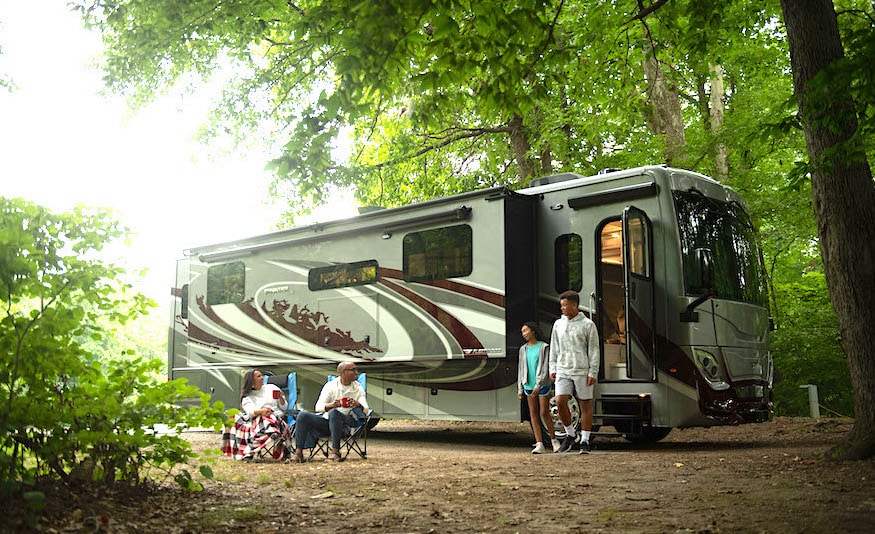
There’s plenty of family time on an RV vacation. Photo courtesy of Fleetwood RV
By Mary Bergin
Picture 39 days of travel yet sleeping in the same cozy bed every night. Seeing a new part of the world without packing and unpacking. Lingering hours or days longer than the average group tour allows.
That’s life for Mark and Grace Fleming of Wisconsin, who recently drove 6,800 miles while pulling a 4.5-ton recreational vehicle most of the time. Their round trip between the Midwest U.S. and West Coast, visiting relatives and friends en route, ended before autumn’s first hard frost arrived.
The journey, their longest in a recreational vehicle (RV), was both a rugged haul and a fine example of what makes their retirement good.
In South Dakota’s Custer State Park, the Flemings rolled through herds of buffalo grazing contentedly beneath hills topped with needle-like granite spires. In Montana, the Beartooth Highway took them along a series of switchbacks and the Billings Brew Trail allowed them to imbibe safely without wandering too far from “home.” They tasted California’s Sonoma County wines at their own pace and walked among the world’s tallest trees at Redwood National Park.
“Our RV has been our ticket to explore the country,” says Mark, who drove 500 miles on some days and nowhere on others. Scenic routes, national parks, caves and historic sites are major lures when the 60-something couple travel.
They are far from alone, especially as the world eases out of a pandemic that demanded social isolation. State and national park visits subsequently surged. RV travel safely satiated wanderlust for more than a day away.
Affordable Luxury on Wheels
Gone is the presumption of “roughing it” in an RV. Today these rolling rigs are capable of toting all the comforts of home: Think full-sized kitchen appliances, queen-size beds, one or more bathrooms, a big-screen TV and an electric fireplace plus a private WiFi-enabled office.
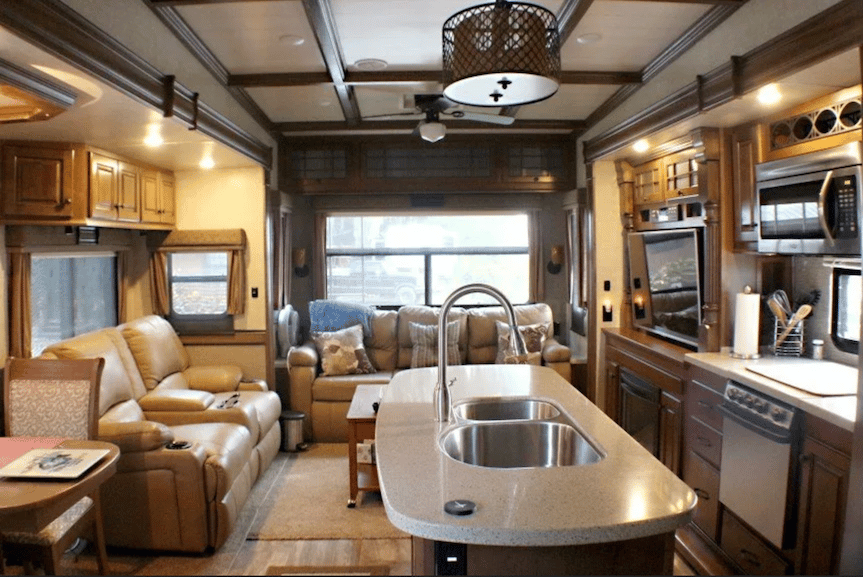
Contemporary RVs offer all the comforts of home without feeling claustrophobic. Slide-outs offer extra space when traveling with friends or a large family.
Rvshare.com reports that interest in RV rentals has grown 650 percent since 2013. Besides extended vacations, the units are rented for overnights near outdoor festivals, music concerts and other hot-ticket events where lodging is scarce or pricey.
Would-be owners tend to rent an RV before buying. International visitors travel this way too: Requirements vary by state, but usually a valid driver’s license, credit card and minimum age of 21 are enough to rent smaller motorhomes. Online videos and RV driving schools teach first-timers how to safely maneuver the vehicle, which is 18 to 45 feet long.
“RV vacations are more affordable than travel by personal car, commercial airline or cruise ship,” the RV Industry Association (RVIA) contends. Savings in lodging and food outweigh high fuel costs.
Although RV gas mileage is dismal (roughly 5 to 15 miles per gallon), researchers say a family of four can save 27 to 62 percent by traveling in an RV. For a couple, the savings potential is 11 to 48 percent.
Those are U.S. averages, but RV travel is an international trend too and expected to grow by $28.62 billion from 2022-26, says ReportLinker.com, which believes the market “is driven by the increasing adoption of RVs by different generations of consumers, the growth in global tourism and the integration of advanced technologies into RVs that allow remote work in almost every location.”
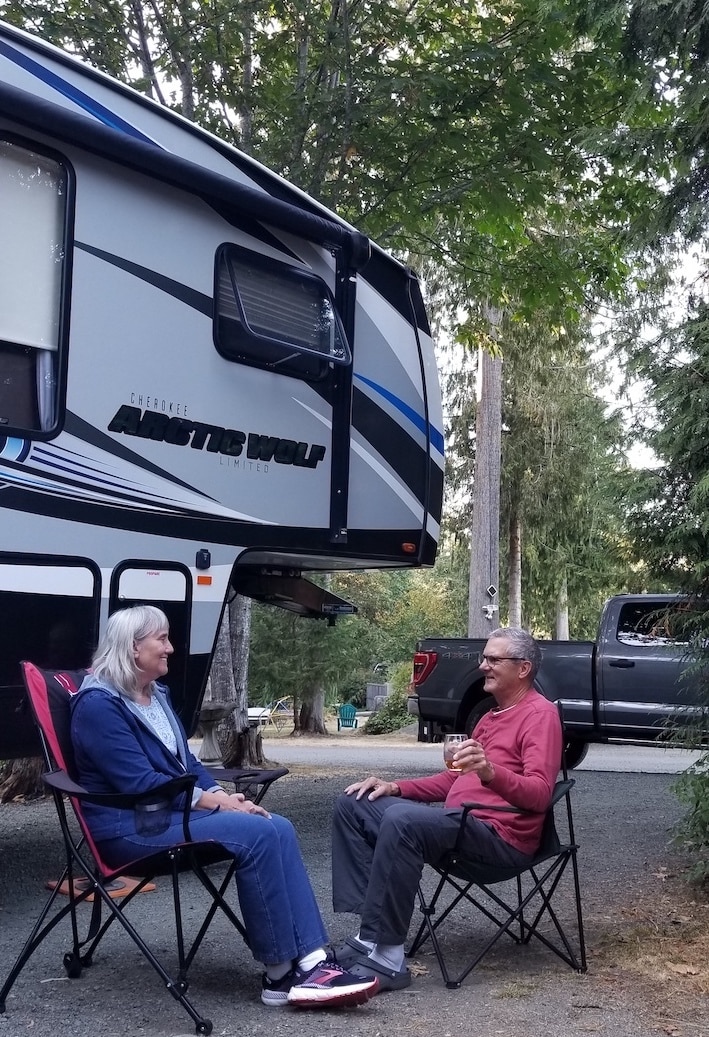
Mark and Grace Fleming attach their 31-ft. Arctic Wolf travel trailer to a pickup truck before hitting the road to visit family or simply see beautiful corners of North America at their own pace.
BC: Before Covid
For the Flemings, RV travel began in 2012, long before Covid emerged. “Our travel pattern has been spending about one month on the road down South in January/February, and one month somewhere else after Labor Day when parks are less busy,” Mark says. They might hook up the RV for a short summer trip too, but it’s more likely parked at the family farm.
The couple bought a 28-foot, pull-behind, Aerolite travel trailer with one slide-out, trading it in six years later for a 31-foot Arctic Wolf with three movable slide-outs.
Living space and amenities vary greatly. So do ease of driving, the weight of the haul and whether an RV is motorized or towed by a hitched vehicle. Slide-outs allow the walls of a parked RV to extend outward, providing more interior living space and often an exterior canopy that can shade an outdoor dining area.
Eleven years ago, the Flemings took a road trip to Upper New York State for a wedding and mused about the cleanliness of inexpensive motels along the way.
“Maybe we should buy a travel trailer so we know bedsheets and floors are clean,” Grace mused, “and we could bring our cats with us.” That was enough to jumpstart Mark’s research.
It was a leap of faith: “Neither Grace nor I had ever pulled a travel trailer, slept in a trailer or even stepped foot in one,” he explains.
Now it’s 50,000 miles later: “We kind of know what we’re doing. We also really like that inside our RV it’s a common, familiar place that’s all ours – with pets allowed – versus strange hotel rooms or rented condos.”
A pickup truck pulls their RV until it is parked at a campsite. Then the tow vehicle is unhooked to explore the surroundings. “We never pull our rig into an urban area unless we’ve taken a wrong turn,” just need to pass through or are heading to an RV park in an urban setting, Mark says.
One example of the latter was a weeklong stay at an RV park two blocks from the French Quarter in New Orleans. Another: Florida (“If you want to get within four miles of either the Atlantic or Gulf coast, you have to drive in urban areas”).
Take Your Lifestyle With You
Mike and Nancy Schumacher of Wisconsin have driven their 2015 Winnebago Navion to 38 states and numerous national parks in five years. The 25-foot, motorized RV with a diesel engine has two slide-outs (one for the bedroom, the other for the living area).
How roomy and convenient is that? They can walk around three sides of their queen-size bed. In the bathroom is a shower. In the kitchen is a refrigerator, stovetop and microwave. “We can drive all day, then pull into an RV park and be settled in a half hour,” Mike says.
They tow a Jeep, for day trips. The first two years, “we only traveled with the RV and no towed vehicle,” Mike recalls. “Parking was sometimes a problem in cities, but worse was the fact that we were sometimes restricted to some areas of national parks because of the RV’s size.”
Being able to “be outside immediately” after awakening appeals to the nature-loving couple, who tend to follow scenic and lesser-traveled routes. “Some secondary roads are four lanes and easier to travel,” Mike says. “We generally travel at a slower pace than most traffic for safety and fuel economy.”
The RV had 7,500 miles when purchased in 2017; the odometer passed 50,000 miles before the Schumachers’ latest trip, to San Diego to babysit for a new grandchild. These Baby Boomers have taken four different routes to San Diego, so far. Nancy documents everything on a U.S. map and keeps a journal of where they slept and what they saw along the way.
“We’ll stay with our son and his family for a while, then store (the RV) while we fly home for November and December,” she says. “We’ll fly back in mid-January, travel around and drive home in March,” visiting national monuments and other sites missed during earlier excursions.
Before buying an RV, the couple traveled much more simply – in conversion vans, then a pop-up camper – “so our Navion seems glamorous,” Nancy says. “It’s so convenient to pull into a campsite, pop out the RV slides, pull the curtains and plug in (electricity). Then we’re set for the night.”
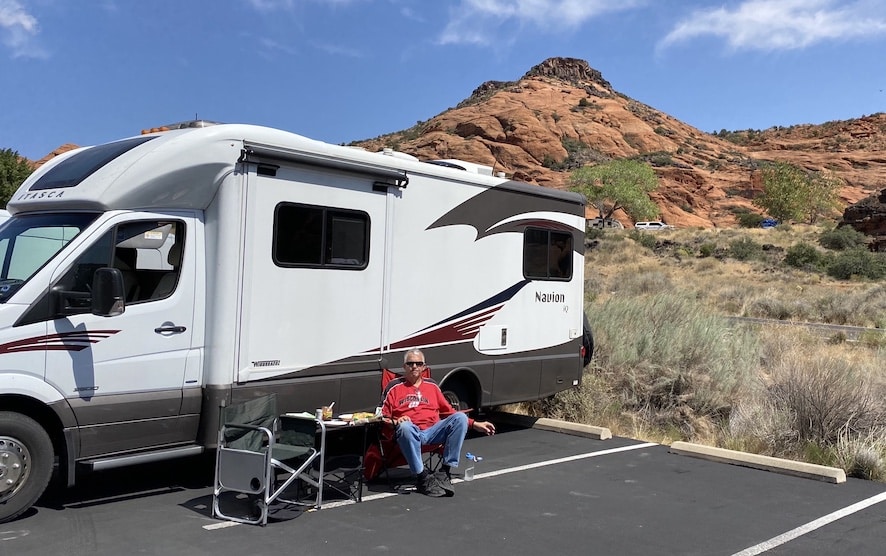
There are no weeds to pull, leaves to rake or grass to cut. So Mike Schumacher ends most of his days relaxing beside his Winnebago Navion, a 25-ft. recreational vehicle equipped with all the comforts of home. After finishing his snack he can go back inside the motorhome and enjoy more interior space by sliding out two of the walls.
Navigating the RV Life
It’s important to know how you and your companions prefer to travel before the adventures begin.
“We are both play-it-by-ear people – we never have specific daily plans,” Nancy says. “I know many people who need to have detailed plans and reservations done before they leave.” For them, certain states, parks or landmarks are general goals.
“Sometimes we find nice urban RV sites: Tucson, San Diego and Long Beach, Calif., have nice parks in the city,” but the couple usually camps outside of big cities. They have stayed at Campland in San Diego multiple times because of the wooded sites and bike trails to the ocean.
“California state beaches have great sites overlooking the Pacific Ocean,” and Georgia’s Skidaway Island, outside Savannah, was pleasant because the roomy, wooded sites are scenic, quiet and near water and hiking trails. The Schumachers also don’t ignore what is close to home: Nancy counts Peninsula and High Cliff state parks in Wisconsin among her overall favorites.
She urges caution when considering RV parks, especially in Arizona and Florida, which “are way too crowded for my taste.” Nancy says many “advertise great pools or services but a few sites are really just crowded parking lots near loud highways or train tracks.”
When researching for more than one overnight, she uses Google Maps to inspect a location before locking in.
Design trends
At least 11 million U.S. households own an RV, says RVIA. That’s a 62 percent increase since 2001 and a 124 percent increase since 1980. The investment – $5,000 to $500,000 – depends on vehicle type, age, size and amenities.
The typical RV owner has an above-average income, is 48 years old, married and travels with their rig three or four weeks per year.
The new Frontier GTX by Fleetwood RV, a part of REV Recreation Group, is a 37-foot-long luxury motorhome that even has a dedicated “corner office” option with a built-in computer monitor and multiple outlets near an L-shaped desk with drawers and cabinets for convenient work file storage.
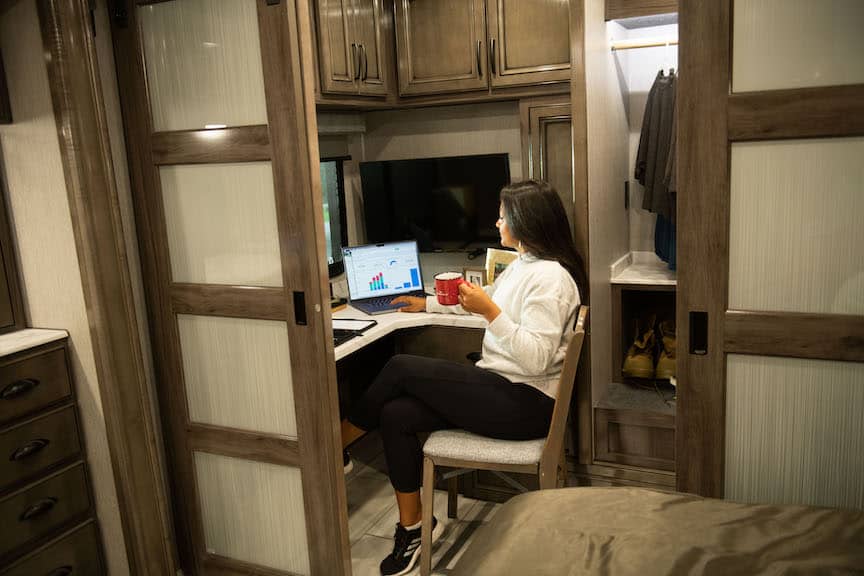
The 37-ft Frontier GTX motorhome includes a dedicated workspace that becomes completely private when the doors are closed. “We found quite a bit of interest in the ability to work remotely and have children engage in distance learning,” explains Doug Miller, product manager for REV Recreation. “We wanted to offer a floorplan that could accommodate the new reality of living, working, and educating anywhere.”
Expandible and Mobile
Three slide-outs on the Frontier GTX – each expands living space by sliding outward when parked – provide privacy and elbow room. That’s especially good for nomadic families.
“We found quite a bit of interest in the ability to work remotely and have children engage in distance learning,” says Doug Miller, REV product manager. “Based on that, we wanted to offer a floor plan that could accommodate the new reality of living, working and educating anywhere.”
Result: Virtual, interactive school activities can happen in the main living area of the coach while business is conducted quietly in an attached but secluded office at the unit’s rear.
Much more compact is REV’s Lance Enduro prototype trailer, 18 feet long and lightweight (for the industry) at 2,700 pounds. It can be pulled by most SUVs. Despite the petite size, it is equipped with a queen bed, dropdown bunk beds, a U-shaped dinette, shower, toilet and outdoor galley-style kitchen.
ReportLinker.com predicts product upgrades and expansions – including RVs fueled by electricity – will drive RV market growth. New concept vehicles include Winnebago Industries’ e-RV, all-electric and with zero emission. From Airstream is the prototype eStream, a towable trailer with a solar rooftop, “fully electric for on- and off-grid camping.”
These possibilities compound already overwhelming choices in the RV marketplace. Thorindustries.com blogs and calculators help initiate the curious.
The largest recreational vehicle manufacturers in the U.S. are in the Midwest, with free factory tours by reservation. That includes Thor in Bristol, Elkhart and Wakarusa, Ind.; REV’s Holiday Rambler factory in Decatur, Ind.; and eStream in Forest City and Lake Mills, Iowa.
GoRVing.com – a consortium of RV manufacturers, dealers and campgrounds – introduces the notion of RV travel and especially promotes RV camping. Among the marketing campaign slogans: “You don’t just need a vacation. You need an RV.”
Cruise America, established in 1972, is the nation’s largest RV rental business (132 locations in the U.S. and Canada). On RVshare.com are 100,000-plus RV owners willing to rent their vehicles.
Feeling spooky? RVTrader.com has compiled lists of haunted travel areas such as roads, forests, harbors and campgrounds.
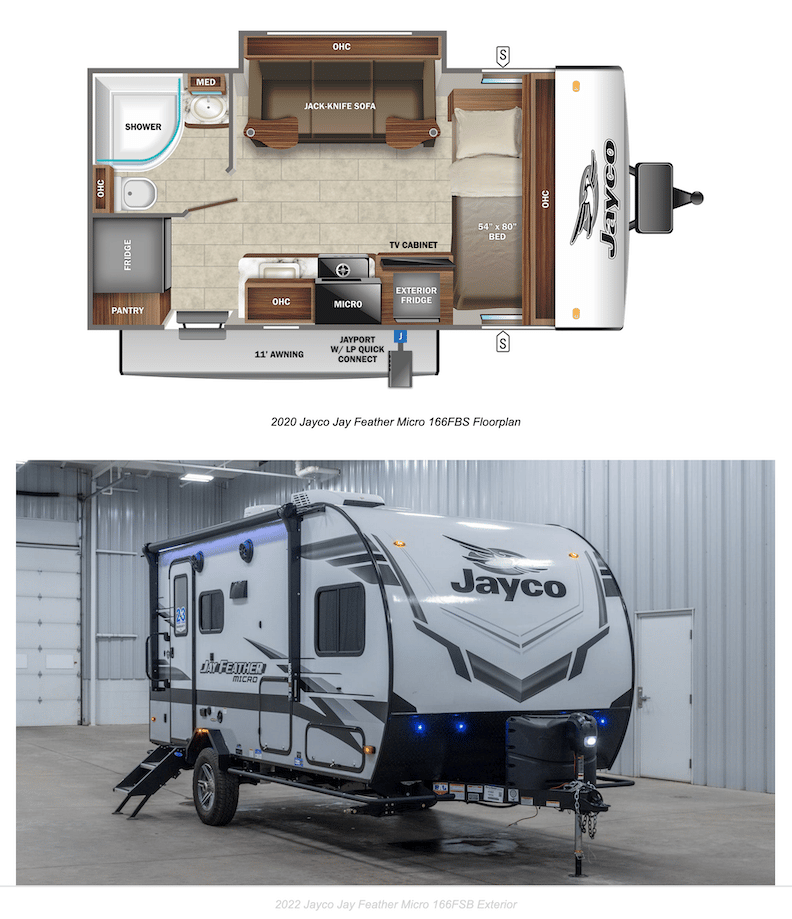
The horizontal cross section of a Jayco travel trailer (above) illustrates how motorized walls that slide out significantly add to the amount of living space.
RVs Masquerading as Airbnbs
You’d like to take the family camping in America, but there’s a problem. You’re a confident driver on Ireland’s meandering lanes, the autobahns of Europe and even Taiwan’s Highway 1 from Keelung to Kaohsiung. But are you really up to piloting a four-ton metal box through American traffic? The good news is that now you don’t have to try since several RV leasing companies such Outdoorsy, Cruise America and RVshare.com will deliver and connect the RV of your choice to the campsite of your choosing. No worries about fuel economy, insurance or the procedure for connecting to fresh water, sewage and electricity. Just reserve a campsite at California’s Yosemite National Park, for example, and your RV will be waiting when you arrive. Instead of paying $3,600 for a six-night stay in a cabin at Walt Disney’s Fort Wilderness Resort in Florida, rent one of the resort’s RV hookups for $1,300, ask a leasing company to have a pre-selected RV waiting on your day of arrival and save $2,300 camping under the forest canopy.
Beyond Vacation
Who knows? If you like it enough, those rolling wheels might turn into a more permanent home. About one million Americans live as full-time RVers, reports The Washington Post.
Since 2017, Suzanne Joiner has traveled and worked while living in a camper that she pulls throughout the country with a Jeep Grand Cherokee. She has visited all 50 states (Hawaii without the camper), accumulating 120,000 miles, most while hauling a Gulfstream vintage cruiser.
An accident in Idaho caused Suzanne to purchase a 23-foot Riverside Retro travel trailer in May 2022. She’s already taken it to Alaska and back.
In addition to a short queen bed, the dinette turns into a bed, but she rarely uses it that way because the area is more useful as her office and kitchen.
“I love this lifestyle because it provides me a ton of flexibility and allows for a work-life integration, not a compartmentalized life,” the Virginia native says. “I don’t feel like life begins with retirement. I do what I want today.”
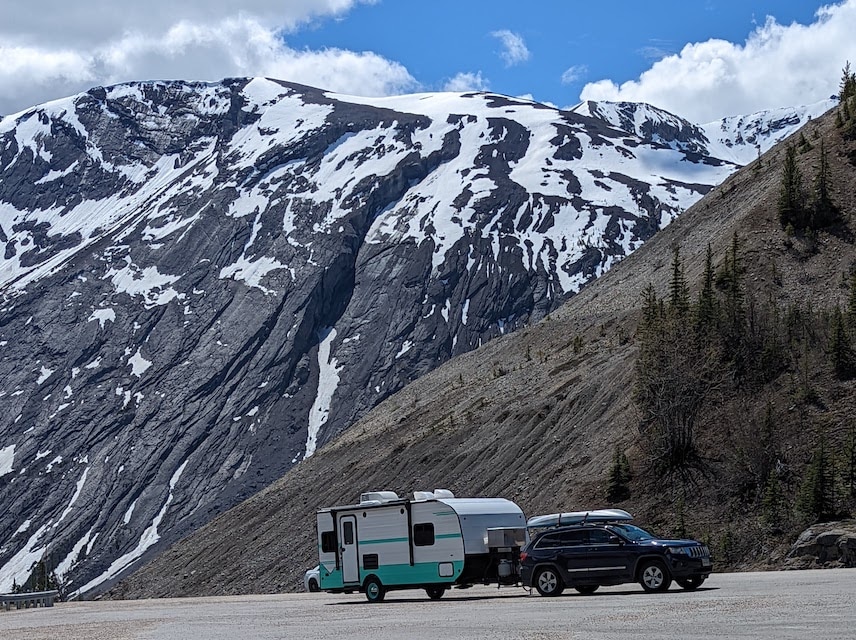
Suzanne Joiner is a full-time business traveler who rarely goes near an airplane. She travels America’s highways on behalf of an Arizona-based nonprofit, spending her nights in a 23-foot travel trailer pulled by her Jeep Grand Cherokee. Says Joiner: “I love this lifestyle because it provides me with a ton of flexibility.”
Joiner, 44, is a senior marketing director for Vitalent, an Arizona-based nonprofit that collects and distributes blood nationwide. Having a mobile lifestyle means “I don’t have to pack and I always have my own bed with me. Plus it allows me the ability to be available for my family when needed.” Virginia Beach is her destination in November, for a sister’s 50th birthday and to help their mother recuperate from knee replacement surgery.
A novel lifestyle? Joiner sees it this way: “I can go wherever I want whenever I want and invite friends to come visit when I’m somewhere interesting. It’s a perfect lifestyle for migratory workers, vagabonds looking to work remotely while on the road or families requiring an adaptable living space that’s not too costly.”![]()
Mary Bergin lives in Madison, Wisconsin. Her previous articles focused on Detroit’s revival and surrounding professional sports stadiums with year-round commercial districts.

